Modellsimulation in Webots und Simulationen mit ROS2: Unterschied zwischen den Versionen
(→Wheels) |
(→Wheels) |
||
| Zeile 168: | Zeile 168: | ||
'''RotationalMotor''' | '''RotationalMotor''' | ||
[[Datei:RotationalMotor.png|thumb|left|mini| | [[Datei:RotationalMotor.png|thumb|left|mini|300px|Fig. 19: Adding RotationalMotor as a device]] | ||
<br clear=all> | <br clear=all> | ||
The motor to drive the wheel is also added inside the HingeJoint. To add a motor We go inside the HingeJoint Node, then we choose RotationalMotor from the 'device' field as Figure 19 depicts. Inside the 'RotationalMotor' node we need to give it a name. We name this as 'wheel1' as we are going to attach this motor to the first wheel along with the hingeJoint. The name is very important because we are going to use the exact same name later when we write the code to drive these motors. | The motor to drive the wheel is also added inside the HingeJoint. To add a motor We go inside the HingeJoint Node, then we choose RotationalMotor from the 'device' field as Figure 19 depicts. Inside the 'RotationalMotor' node we need to give it a name. We name this as 'wheel1' as we are going to attach this motor to the first wheel along with the hingeJoint. The name is very important because we are going to use the exact same name later when we write the code to drive these motors. | ||
Version vom 17. März 2022, 11:34 Uhr
Autoren: Arfat Kamal
Betreuer: Prof. Schneider
Art: Praxissemester
Projektlaufzeit: 02.11.2021-20.02.2022
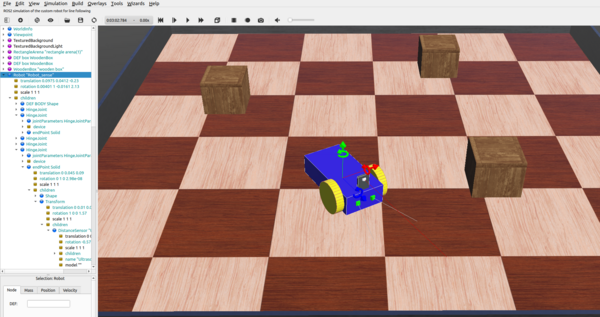
Introduction
In order to simulate, a 3D model of a 4 wheeled robot is created inside Webots first. That robot is simulated with a controller which is written in C inside the text editor of Webots. That robot is later imported in Webots in Ubuntu and customised with a servo, an ultrasonic sensor and a caster wheel to resemble the Alphabot robot of our project. Finally, it is programmed with ROS2 and Python to run it in Webots as an obstacle avoiding robot.
Overview
Documentation
3D Model of a 4-Wheeled-Robot
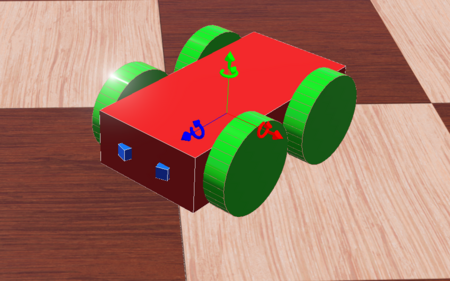
A 4-Wheeled-Robot is created in Webots from scratch by following tutorial 6 in Cyberbotics. The robot consists of a body, 4 wheels and two distance sensors(IR sensors). Figure 2. above shows the 3D view of the end result.
Co-ordinate System
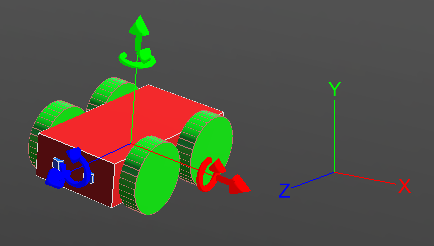
The co-ordinate system of the robot works exactly as the picture above depicts. The red arrow shows the X-axis and it defines the right and left of the robot. The green arrow shows the Y-axis and it can be used to move the robot upwards and downwards. The blue arrow is the Z-axis and it is related to forward and backward movement of the robot. By default the co-ordinates system is turned off in Webots. It can be turned on by following these steps to show the X, Y and Z axis:
View >> Optional Rendering >> Show Coordinate System
Or by simply pressing Ctrl+F1.
Top View in a Grid
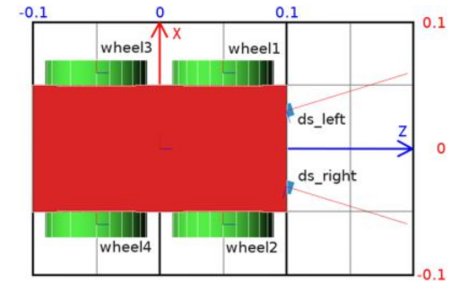
The figure above shows the top view of the robot. It is inside a grid to understand the dimensions of the robot. The dimension of the grid is 0.2 × 0.3 meters.
High Level Representation
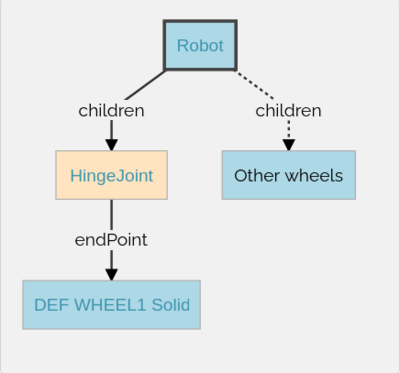
The picture above depicts the high level representation of the 4 wheeled robot. Here, Robot is the base node. The Robot node has four HingeJoint nodes. The HingeJoints are used as anchors to connect the wheels to the body of the robot. Each HingeJoint has a Solid node as endPoint. The Solid nodes are then modified into the wheels of the robot.
Low Level Representation
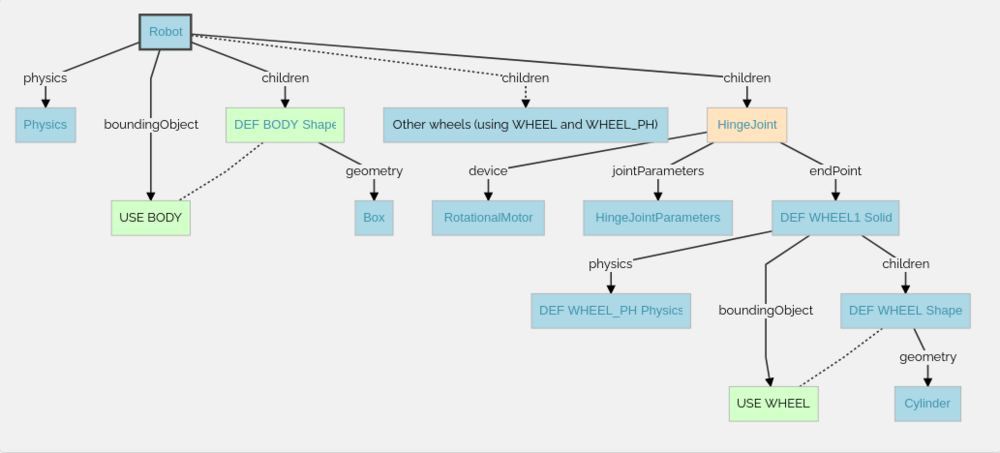
The figure above demonstrates the structure of the robot in details, how the 3D model is modeled in Weobts using the scene tree. The steps of the Low Level Representation will be explained in detail inside the 'Creating the 3D Model' section.
Representation of a HingeJoint
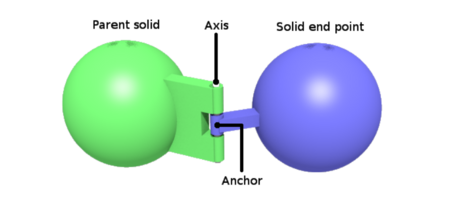
In Webots, whenever rotary or linear motion is used, we must use a HingeJoint. In our case, since we are using RotationalMotor for moving the wheels, HingeJoints are being used to anchor the wheels to the body. As we can see in the photo, Parent solid is in our case the body of the robot and wheels are attached as solid end points. In the HingeJoint node we also use RotationalMotor as a Device for moving the robot.
Sensors
In our case, two IR sensors are used to measure distance in the beginning for the 4-Wheeled-Robot. In Webots these sensors are found as DistanceSensors. There are four type of distance sensors in Webots. They are -
- Generic,
- Infra-red,
- Sonar,
- Laser.
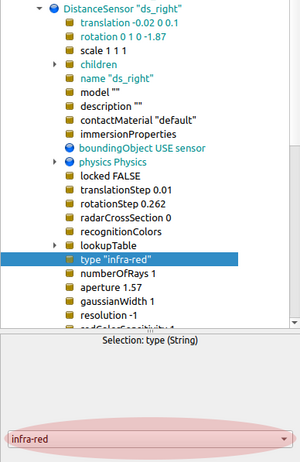
In Webots, these different types of distance sensors can be found inside DistanceSensor Node which is under the Children node of the Robot base node. There is an example in Figure. 8 that shows how to change between different types of Distance Sensors by selecting the 'type' field of DistanceSensor from the scene tree. Later when we use Ultrasonic Sensor for avoiding obstacles, we change the type of the DistanceSensor to Sonar.
Creating the 3D Model
Body
The first step to create the 3D model of the robot is to make the body. In order to create the body of the robot at first we add a Robot node as a base node inside the scene tree. Then inside the Robot node we have to go inside the Children node. Inside the Children node we again go inside the Base nodes. From Base nodes we add a Shape inside the scene tree. This shape should be transformed into the body of the robot.
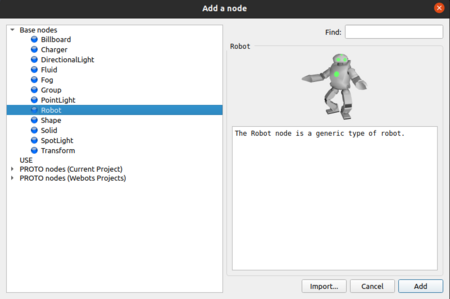
The above photo in Figure 9 shows how a Robot Node is added inside the scene tree by simply clicking on the 'add' icon from Webots terminal. The steps to add a shape inside the Robot node to make the body is given below:
Robot > Children > Base Nodes > Shape
Appearance
First we have to change the appearance of the shape. To do that we go inside the Shape from the scene tree and click on Appearance and choose PBRAppearance. Inside the Appearance Node, We can change the color by changing the baseColor which is in RGB format. We can also change the Metalness to 0 and the Rougness to 1 to make it look better.
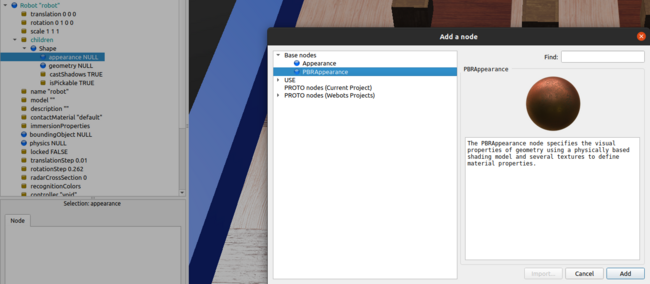
The above photo in Figure 10. shows how PBRAppearance is added as appearance of the Shape of the body of the Robot.
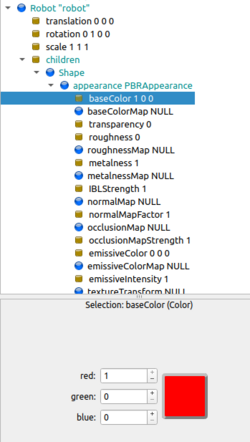
The Base Color of the robot can be set to Red by changing the RGB value of the BaseColor Node as it is shown in Figure 11. We do this by setting the value of Red to 1 and 0 to Green and Blue.
For changing the metalness of the body, we follow the following steps:
Robot > children > Shape > appearance > metalness > set to 0
The same way we can also change the roughness of the shape. We only change the metalness and roughness of the shape so the color appears better. The roughness can be changed by following the steps below:
Robot > children > Shape > appearance > roughness > set to 1
Geometry
We need to give a geometry to the Shape of the robot. To do that we have to go inside the Shape Node and click on 'geometry'. Then we go inside Base nodes and choose 'Box' since the body of our Robot has the geometry of a box. We can also change the size of the box from 'geometry'. We simply select the 'size' field which is inside 'geometry'. There we can see three fields for changing the size of the box with x,y and z values. For our case, x is 0.1 m, y is 0.05 m and z is 0.2 m. The end result looks like the Figure 12 below.
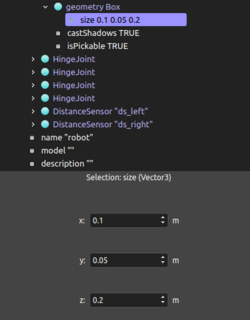
DEF Mechanism
We have this 'DEF' option in Webots to Define something under a certain name. Which is helpful sometimes when we want to use the same values of something for something else, so we do not have to recreate everything from scratch. This is also helpful when we want to use a shape or something as a bounding object. In our case we defined the Shape that we turned into the body of the robot as 'Body'. We can do this by selecting the Shape node and writing 'Body' inside the empty field after 'DEF'. The 'DEF' field can be found right under the scene tree. A graphical representation of the DEF Mechanism can be found in the Figure 13. below.
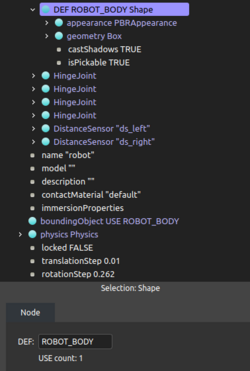
BondingObject
Once we define the Shape as the Body of the robot, we can select it as the bounding object of our robot. We use bounding object so other solid items from the world do not go inside the robot. We can do this by selecting the boundingObject field which is a part of the Robot base node. Once we select the boundingObject, We can go inside 'USE' and select the box shape that we created and defined as 'ROBOT_BODY'. Since the body of the robot is the biggest part of our robot, we choose this as the bounding object of the Robot Node. Figure 14. below demonstrates how BoundingObject can be selected in Webots.
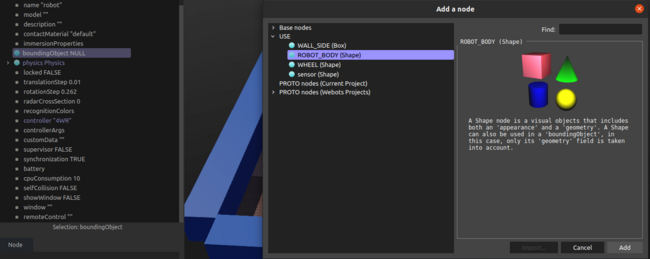
Physics
And lastly we change the Physics of the Robot Node from 'null' to 'physics.' Figure 15. below shows how physics is added to a node. We simply click on Physics, which is by default set to null. Then from the Base nodes we choose 'Physics'. Once we do this, physics is added to our robot node and we can see some attributes like density, mass, center of mass, are also added under the 'Physics' node in the scene tree. We do not have to make any changes to these attributes. We just leave them as it is.
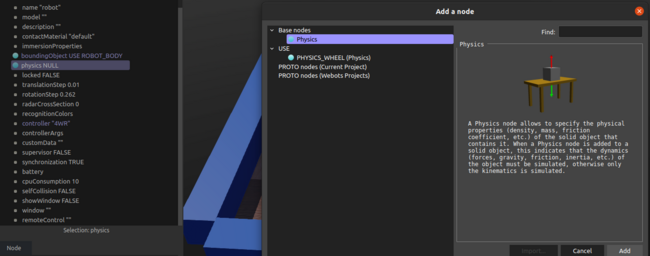
After doing all the changes to the Shape of the body, modifying the appearance, adding geometry and physics, the end result of the body of the robot looks like Figure. 16 below -
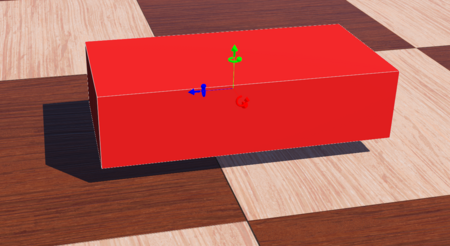
Wheels
To add wheels to the Robot, firstly we need to add HingeJoints. Whenever we want to add something to the Robot, we must add it to the Children Node of the Robot Base Node. Adding HingeJoints is also done with the same procedure. For adding HingeJoint we have to click on 'add' while we are inside the Children Node. Then we just have to choose 'HingeJoint' from the options inside of Base Nodes.
Once we have added the HingeJoint, we have to configure the jointParameters, add a RotationalMotor as the device and add a solid as an endPoint as it is found in Figure 17.
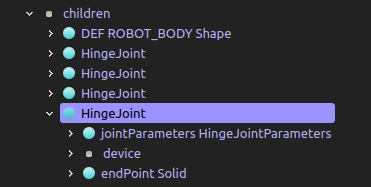
JointParameters
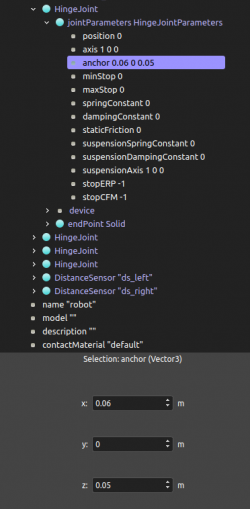
In jointParameters, the first thing we do is adding HingeJointParameters from the base nodes. This will allow us to manipulate the joint parameters attributes. We change the axis value to 1 in x direction and leave y and z to 0. We also need to change the x, y and z values of the anchor field. This should be the same as the position of the wheel. The anchor is set to 0.06m in x, 0m in y and 0.05m in z direction as it can be seen in Figure 18 above.
RotationalMotor
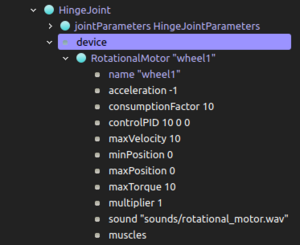
The motor to drive the wheel is also added inside the HingeJoint. To add a motor We go inside the HingeJoint Node, then we choose RotationalMotor from the 'device' field as Figure 19 depicts. Inside the 'RotationalMotor' node we need to give it a name. We name this as 'wheel1' as we are going to attach this motor to the first wheel along with the hingeJoint. The name is very important because we are going to use the exact same name later when we write the code to drive these motors.
For adding the wheel to the HingeJoint, first we need to add a Solid Node to the endPoint of the HingeJoint Node. The Solid Node is then transformed into a wheel. To do that we have to add a shape from the Base Nodes of the Solid. Then we change the appearance of the shape from to null to PBRAppearance. We also need to make some changes of the geometry which is also a part of the appearance. In Geometry Node, first we need to give it a geometry of a cylinder since the wheel of our robot is also of the shape of a cylinder. Then we should give some dimension to the wheel by changing the values of height and radius. The height of the wheel is set to 0.02 meters and the radius is set to 0.04 meters.
When we are done customizing the shape of the wheel, we can save all the customization by defining the wheel by using the 'DEF' field which can be found under the scence tree. We can do this by selecting the shape that we modified to a wheel and then we just simply name it anything inside the 'DEF' field. This is an useful feature of Webots, because it will allow us to use the defined shape in the future when we want to add more wheels. We will not have to do all the customizations of the shape again. Here we define the wheel as 'wheel'.
Once we have defined it, we can use it now as a bounding object. To do that we go inside of 'endPoint Solid' Node. From there we select boundingObjects, then 'Use' and select Wheel. We can add physics to the wheel same way. By clicking on 'physics' and then choose 'Physics' from the Base Nodes.
After that we make some changes to the translation and rotation inside the 'endPoint' Node to select the position of the wheel in relation to the robot. The 'translation' field has 3 values - x,y and z. We change the x value to 0.06, y to 0 and z to 0.05. For the rotation we will change the z value to 1 and leave x and y to 0. For the angle we make it 1.57, which 90 degrees in radian.
We can also change the color of the wheel by changing the baseColor. We can find it inside appearance which is sub field of 'shape' node of the 'endPoint Solid' node. For our Robot we set the color of the wheel to Red by changing the RGB field inside 'baseColor' node. We can do it simply by making 'r' to 1 and leaving 'g' and 'b' to 0. Inside 'appearance' we also have these two fields 'metalness' and 'roughness'. For better visibility we change the 'metalness' to 0 and 'roughness' to 1.
Once we are done adding the first wheel, adding the rest of the wheels become quite easy. Since we saved the first wheel from the 'shape' node by defining it with the 'DEF' field, now we can use the saved shape 'wheel' for all the other wheels. We just need to change the translation of the wheel for each wheel as it defines the position of the wheel on the Robot. For the second wheel, we just change the x value of the translation to -o.06, y and z remain the same as the first wheel. For the 3rd wheel the translation is - x: 0.06, y: 0, z: -0.05. For the 4th wheel the translation is - x: -0.06, y: 0, z: -0.05.
Demo-Programs
Software
Summary
Weiterführende Links
→ zurück zum Hauptartikel: Praxissemester Projektteam WS2021